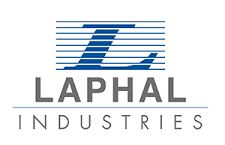
Laphal Industries chose Prexima 300 for its manufacturing site in Rousset, France.
Power to the essential.
Introduction
Introduction since early 1970s, Laphal Industries has provided its customers with experience and know-how in the production and distribution of medicines and food supplements. Today its human potential and latest high-tech investments establish Laphal as one of the main players in the pharmaceutical outsourcing market.
Two highly specialized manufacturing sites cover the whole production: the site in Allauch is specialized in liquid and pasty forms, while the site in Rousset is specialized in oral solid dosage forms – capsules, granules, tablets, both naked and coated. Also based in Allauch, the logistics department ensures the distribution of medicines and food supplements in France and abroad to wholesaler distributors, pharmacists, pharmaceutical sales representatives and medical visitors. Recently acquired, Pasquier Laboratoire is specialized in the manufacture and packaging of liquid forms with heat treatment.
Heat sensitive products are only one of the difficult-to-manage drugs handled by Laphal during their production campaigns. «Some of the drugs we produce were formulated a long time ago and are not necessarily optimized for today’s standard», recount us David Chaffaut, Site Production Manager at Laphal Industries. «Our challenge is to produce, even with the oldest formulations, drugs that meet the current level of quality». To overcome this challenge, Laphal chose Prexima 300 for its manufacturing site in Rousset, France.
Which was the most restrective requirement for the new tablet press you were looking for?
Tablet presses are commodities. Despite machine manufacturers’ promotion, these machines offer very few extras for drugs producers as we are. Only two types of tablet presses have, to my knowledge, different operating systems: Comprima, with its centrifugal feeding system, and other tablet presses whose regulation is based on displacement at pre-compression. A part from this, tablet presses dating back the 90s already have everything you need to produce the majority of products. However, to use these machines properly, you must have full access to the machine control system – and this is not necessarily possible with all the machine suppliers, except to pay prohibitive amounts. The most restrictive requirement for the new tablet press was to have full access to the machine control system at reasonable costs. I was able to find this on Prexima.
What was your main reasons for choosing Prexima 300?
We scouted for various suppliers, some of which were too expensive for us. Several things quickly pleased me with Prexima 300, a well throught-out machine that incorporates the essentials of new technologies without bothering with new, more expensive systems, which do not add much to machine performance. In the end, we selected two potential suppliers: IMA Active was one of them. Our R&D Manager, Mohamed Goulan, and our Manufacturing and Development Manager, Hamid Chaabihi, went to test the two machines and finally chose Prexima 300 for several reasons.
Firstly, the machine was in our budget. Secondly, the control system was fully accessible and very familiar to us because we already had an IMA Active capsule filler. Finally, our previous experience with IMA had shown us the quality of the service. I would say that IMA salesmen have become professional friends we can count on.
Which three main criteria do you appreciate the most in the machine?
Honestly speaking, Prexima 300 is not a revolutionary machine. However, it is well throught-out and well designed. Its control system is very intuitive and easy to learn for operators – less than a week, whether for format change or driving. The machine design is clever and allows IMA to bring all the essentials – ie. geared motor, eccentrics for penetration, gas compensator for the protection of punches, filtration system lubricating oil – while keeping price low. The auto-regulation system is also smart.
When compression forces exit from the hysteresis zone, the HMI adjusts the dosage with two different correction factors, with respect to the distance from the target value. In this way, a rapid adjustment occurs when values are too far away from the target, reducing the number of rejected tablet. In case of minimum discrepancies, a smoother adjustment occurs, increasing the stability of the process around the target value. I also like the “human IPC” system which is a bit of a “manual check master”.
How was the collaboration with IMA R&D Process Laboratory?
There was a little misunderstanding at the start: as I said, Hamid and Mohamed had been able to test the machine before I came for the FAT, so unless some open points to clarify, the machine was already accepted for me. We did all the IMA tests and I added mine. My tests were not understood right away and Federica Giatti, IMA Active technologist working with us, rightly remarked: «He doesn’t test the machine, he tests the product». She was right, I was preparing for the validations that I was going to have to do when we received it on site.
Once this misunderstanding was cleared up, everything went in the best possible way. I would like to take advantage of your questions to thank IMA Active for the professionalism they showed during the FAT. Today we are in the 7th validated product campaign and I must say that Prexima gives me full satisfaction.


